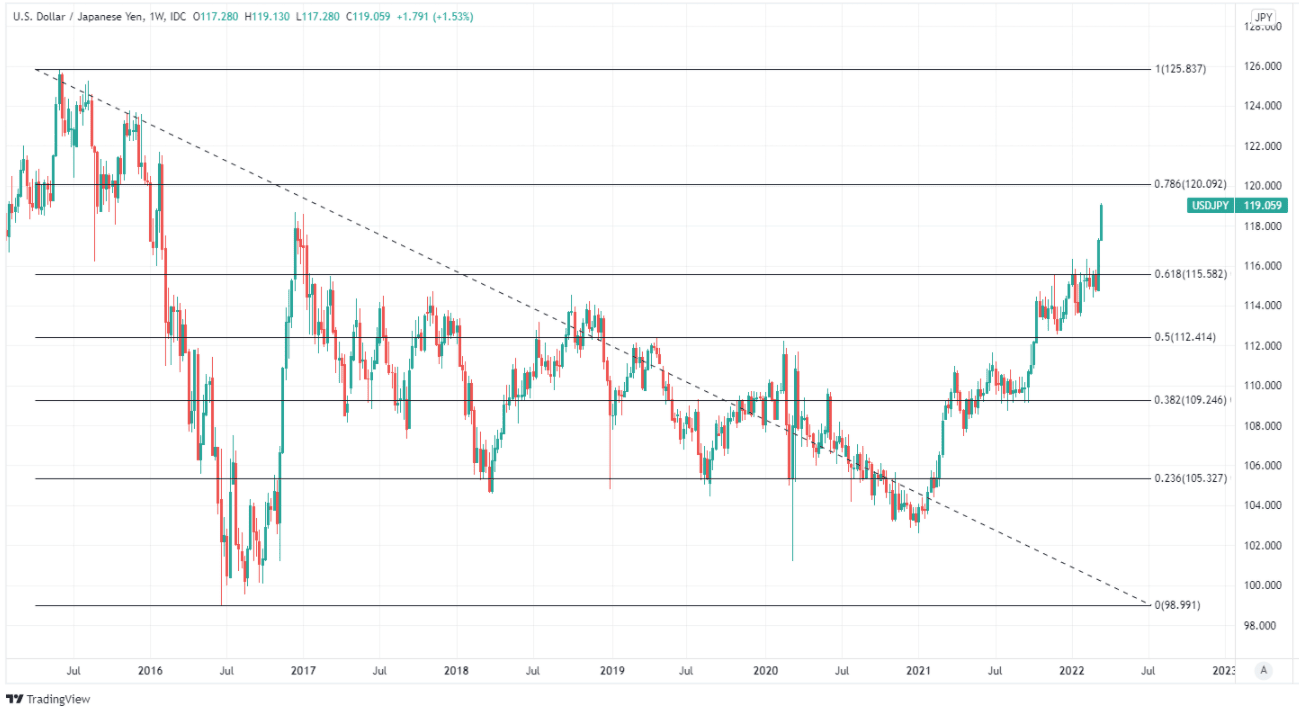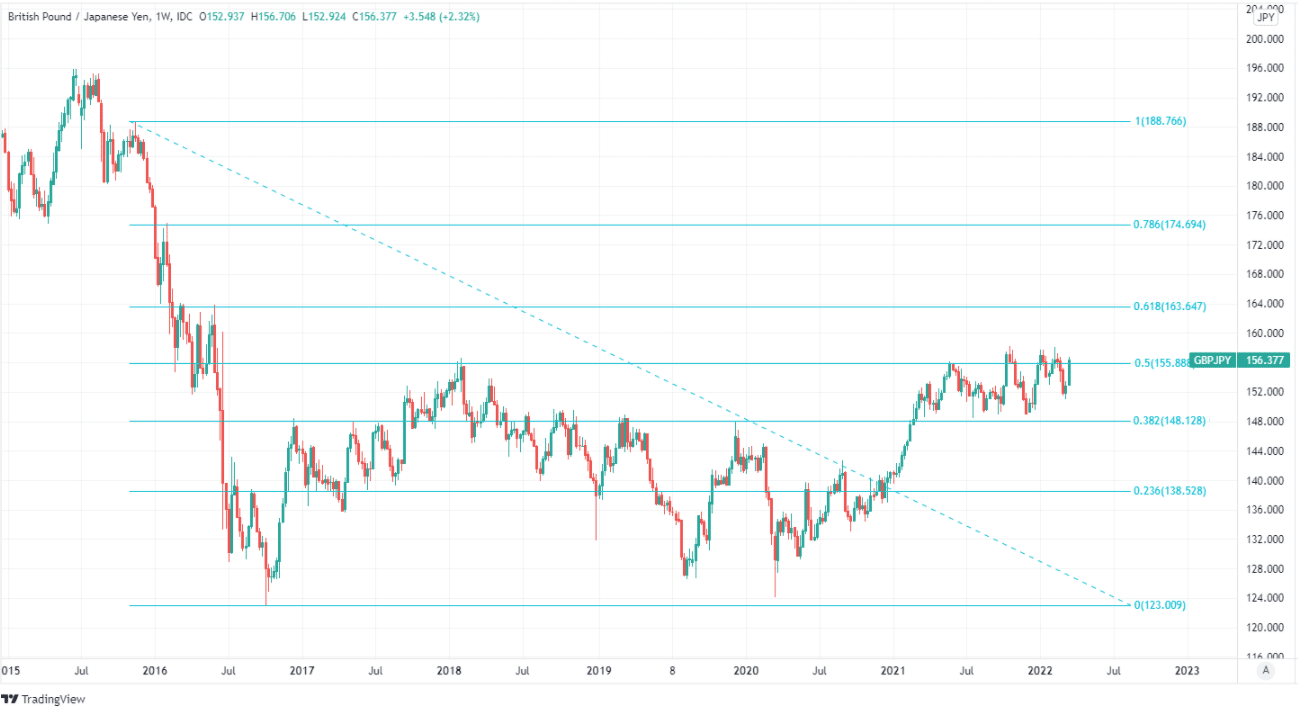Japanese Yen Seen Rising Past $120.0 but GBP/JPY Upside Limited
- Written by: James Skinner
-
- USD/JPY seen probing above 120.0 in near future
- GBP/JPY could struggle near 2021 high at 158.23
- Divergence between Fed, BoJ policy stances cited
- BoJ commits to negative rates as Fed aims higher

Image © Adobe Stock
The Japanese Yen remained an underperformer this week when it added to earlier declines against the Dollar and other currencies but some strategists see it falling further in the weeks ahead due to a growing gulf between the Federal Reserve (Fed) and Bank of Japan (BoJ).
Japanese Yen were sold for most major currencies through much of the week but losses deepened on Friday following the March monetary policy decision from the Bank of Japan, which indicated clearly that it will likely retain an exceptionally loose policy stance for some time to come.
While BoJ officials acknowledged that Japanese inflation has risen of late despite steep reductions in prices within the telecommunications component of the consumer price index, it attributed much of the increase to changes in commodity prices on international markets.
“The BoJ expects high energy prices to push up inflation. However, core inflation remains weak with a 1%/yr fall in February. Thus, we expect the BoJ to stick to ultra‑loose policy for the foreseeable future,” says Joseph Capurso, head of international economics at Commonwealth Bank of Australia.
The BoJ noted on Friday that measures of expectations for inflation had risen “moderately” but reiterated that non-energy inflation is likely to remain far below the bank’s two percent target for the foreseeable future, necessitating continued extraordinary monetary support for the economy.
Above: USD/JPY shown at weekly intervals with Fibonacci retracements of 2015 downtrend indicating likely areas of medium-term resistance to any further gains. Click image for closer inspection.
Secure a retail exchange rate that is between 3-5% stronger than offered by leading banks, learn more.
BoJ support includes a benchmark interest rate set at -0.1%, an unlimited quantitative easing programme (QE) intended to ensure that 10-year government bond yields remain around zero percent and monetary provisions to enable the purchase of vast amounts of financial assets.
All of this is with a view to keeping financial conditions accommodative enough to stimulate economic activity and attain the two percent inflation target.
“Policy rates are still expected to “remain at current level or lower levels”, so no signs of the BOJ departing from the dovish baseline,” says Terence Wu, an FX strategist at OCBC Bank. “Any USD-JPY dip in response to USD weakness has been very shallow. With the pair looking to consolidate between 118.50 and 119.00, the next multi-session target may well be the 120.00 psychological level.”
The BoJ’s policy has long weighed on the Japanese Yen but Friday’s recommitment to continue with it comes just as the Federal Reserve is beginning to lift its own interest rate from the near-zero level that has prevailed since the onset of the coronavirus crisis.
Above: USD/JPY shown at weekly intervals alongside GBP/JPY.
- Reference rates at article's last update:
GBP/JPY: 156.80 - High street bank rates (indicative): 151.33 - 152.43
- Payment specialist rates (indicative): 155.41 - 155.72
- Find out more about specialist rates and service, here
- Set up an exchange rate alert, here
This is widely expected to widen the gap between Japanese government bond yields and those available in the U.S., which is part of the reason why some strategists are now looking for the USD/JPY rate to rise to 120 and above during the weeks and months ahead.
“Given the risks that market pricing is justified and the Fed continues to surprise in a hawkish direction, we recommend staying long USD/JPY, and extend our recommended target from 1.20 to 1.25,” says Matthew Hornbach, global head of macro strategy at Morgan Stanley, in a Thursday note.
Recent increases in USD/JPY have also had an uplifting impact on GBP/JPY, although the latter has risen by less owing to concurrent weakness in Sterling,which could potentially ensure the Pound to Yen exchange rate remains trapped beneath its late 2021 high around 158.23.
GBP/JPY tends to closely reflect the relative performance of the Pound and Yen when each is measured against the U.S. Dollar, although the rub for Sterling is that appetite for it was dampened on Thursday by the March monetary policy decision from the Bank of England (BoE).
Above: GBP/JPY shown at weekly intervals with Fibonacci retracements of 2015 downtrend indicating likely areas of medium-term resistance to any further gains by Sterling. Click image for closer inspection.
While the BoE lifted its own interest rate back to March 2020 level of 0.75%, the bank warned of two-sided risks to future policy decisions and reminded that recent surges in oil and gas prices will have an adverse impact on household incomes as well as the broader economy.
“Unlike the Fed, the BoE delivered a cautious 25bp rate hike yesterday, with one dissenter voting for unchanged rates. The market removed roughly one 25bp hike from its expectations this year (Bank Rate now priced at 1.90% in December),” says Francesco Pesole, a strategist at ING.
The BoE even suggested that energy prices and squeeze on incomes could ultimately be significant enough to serve as a substitute for any further increases in Bank Rate given that it will be likely to put significant downward pressure on domestically generated inflation in the months ahead.
Many investors and traders had been wagering increasingly that Bank Rate would rise to 2% or more later this year, which is likely why Thursday’s statement was followed by a modest sell-off in GBP/USD that also had the effect of weighing on GBP/JPY.
“In short, we suspect the dollar will stay bid on dips against European FX and the JPY, while the commodity-exporting currencies can continue to outperform,” Pesole and colleagues also said on Friday.









